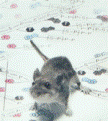Papers in the Biological Sciences

Jay F. Storz Publications
Document Type
Article
Date of this Version
2012
Abstract
House mice (genus Mus) harbor extensive allelic variation at two tandemly duplicated genes that encode the β-chain subunits of adult hemoglobin (Hb). Alternative haplotypes differ in the level of sequence divergence between the two β-globin gene duplicates: the Hbbd and Hbbp haplotypes harbor two structurally distinct β-globin genes, whereas the Hbbs haplotype harbors two β-globin duplicates that are identical in sequence. One especially salient difference between the s-type Hbs relative to the d- and p-type Hbs relates to the number of reactive β-chain cysteine residues. In addition to the highly conserved cysteine residue at β93, the d- and p-type Hbs contain an additional reactive cysteine residue at β13. To assess the functional consequences of allelic variation in β-globin cysteine content, we measured O2-binding properties and H2O2-induced oxidation rates of mono- and dicysteinyl β-Hbs from 4 different inbred strains of mice: C57BL/6J, BALB/cJ, MSM/Ms, and CAROLI/EiJ. The experiments revealed that purified Hbs from the various mouse strains did not exhibit substantial variation in O2-binding properties, but s-type Hb (which contains a single reactive β-chain cysteine residue) was far more readily oxidized to Fe3+ metHb by H2O2 than other mouse Hbs that contain two reactive β-chain cysteine residues. These results suggest that the possession of an additional reactive cysteine residue may protect against metHb formation under oxidizing conditions. The allelic differences in β-globin cysteine content could affect aspects of redox signaling and oxidative/nitrosative stress responses that are mediated by Hb-S-nitrosylation and Hb-S-glutathionylation pathways.


Comments
Published in Comparative Biochemistry and Physiology, Part A 161 (2012), pp. 265–270; doi: 10.1016/j.cbpa.2011.11.004 Copyright © 2011 Elsevier Inc. Used by permission. Journal homepage: www.elsevier.com/locate/cbpa